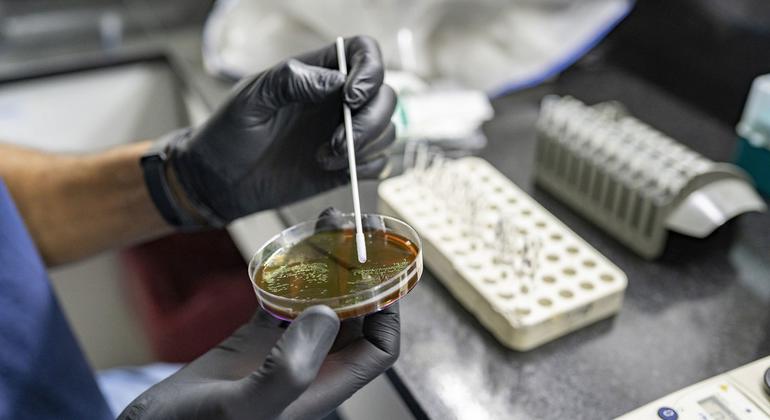US Reports First Human Case of Bird Flu from Livestock – What a Shock!
 Всемирная организация здравоохранения (ВОЗ) сообщила во вторник о первом лабораторно подтвержденном случае инфицирования человека вирусом гриппа A(H5N1) от скота. Об этом ВОЗ проинформировал национальный координационный центр реализации Международных медико-санитарных правил (ММСП) Соединенных Штатов Америки.
Всемирная организация здравоохранения (ВОЗ) сообщила во вторник о первом лабораторно подтвержденном случае инфицирования человека вирусом гриппа A(H5N1) от скота. Об этом ВОЗ проинформировал национальный координационный центр реализации Международных медико-санитарных правил (ММСП) Соединенных Штатов Америки.
Симптомы у пациента из штата Техас, который работал на ферме с коровами, предположительно инфицированными вирусом птичьего гриппа, появились 27 марта. Это первый случай заражения человека вирусом A(H5N1), полученным при контакте с инфицированным крупным рогатым скотом, и второй подтвержденный случай гриппа A(H5N1), выявленный в США. Других случаев заражения человека гриппом A(H5N1) пока не выявлено.
Поскольку вирус не приобрел мутаций, способствующих передаче среди людей, ВОЗ оценивает риск для здоровья населения, связанный с этим вирусом, как низкий, а для лиц, подвергающихся профессиональному риску, риск заражения считается умеренным.
Вирусы гриппа А обычно циркулируют среди животных, но могут заражать и людей. Инфекция у людей в основном происходит при прямом контакте с инфицированными животными или зараженной окружающей средой. В зависимости от первоначального носителя вирусы гриппа А можно классифицировать как вирусы птичьего гриппа, свиного гриппа или другие типы вирусов гриппа животных. Инфекции вируса птичьего гриппа у людей могут вызывать как легкие заболевания верхних дыхательных путей, так и более тяжелые болезни, которые могут привести к летальному исходу.
Вирусы гриппа А и В вызывают сезонные эпидемии среди людей. При этом, согласно современным научным данным, пандемию глобального масштаба способны вызвать только вирусы типа А. Вирусы гриппа А обнаруживаются у многих видов животных. Появление штамма вируса гриппа А, способного инфицировать людей и устойчиво передаваться от человека к человеку, может вызвать пандемию гриппа.
Основным естественным носителем большинства подтипов вирусов гриппа A являются дикие водоплавающие птицы. Вспышки птичьего гриппа среди домашней птицы чреваты непосредственными и серьезными негативными последствиями для сельскохозяйственного сектора.
Международные медико-санитарные правила представляют собой разработанный в рамках ВОЗ универсальный юридически-обязывающий инструмент реагирования на кризисные ситуации в общественном здравоохранении, в том числе санитарно-эпидемиологического характера. Согласно ММСП, страны обязаны уведомлять ВОЗ и другие государства о событиях, выявленных национальной системой эпиднадзора.
Lila Montgomery is a celebrated journalist who has a deep commitment to global affairs and humanitarian issues. Her extensive reporting on United Nations initiatives across the globe has brought critical stories to the forefront, stories that affect communities everywhere.




Is there any information on how the infected person in Texas contracted the avian flu virus from cattle? Was proper safety protocol followed at the farm?
Symptoms in the patient from Texas, who worked on a farm with cows potentially infected with avian flu virus, appeared on March 27. This is the first case of a human being infected with A(H5N1) virus by contact with infected cattle, and the second confirmed case of A(H5N1) flu identified in the USA. No other cases of human infection with A(H5N1) flu have been identified yet. As the virus has not acquired mutations conducive to human-to-human transmission, the WHO assesses the population health risk associated with this virus as low, and for individuals at occupational risk, the risk of infection is considered moderate. Influenza A viruses usually circulate among animals but can also infect humans. Human infection mostly occurs through direct contact with infected animals or contaminated environment. Depending on the initial host, influenza A viruses can be classified as avian influenza viruses, swine flu, etc.
The reported case of bird flu transmission from livestock to a human in the US is indeed concerning. It highlights the importance of strict biosecurity measures in farms to prevent such outbreaks. Let’s hope this remains an isolated incident and doesn’t escalate further.
The reported case of bird flu transmission from livestock to a human in the US is indeed concerning. It’s crucial to monitor the situation closely and take preventive measures to prevent any further spread of the virus. Let’s hope for a swift containment of the outbreak.
The news about the first human case of bird flu from livestock is truly alarming. We must stay vigilant and ensure that necessary precautions are taken to prevent further spread of the virus. Let’s hope for a swift and effective response from health authorities.
The reported case of bird flu transmission to a human from livestock is indeed concerning. It is crucial for authorities to closely monitor and control the spread of the virus to prevent a potential outbreak. Let’s hope for a swift and effective response to protect both human and animal health.
Can you clarify if this transmission of bird flu from livestock to humans is a common occurrence or an isolated incident?
Transmission of bird flu from livestock to humans is relatively rare and considered an isolated incident. The World Health Organization (WHO) has stated that the risk to the general population is low, with moderate risk for individuals at occupational exposure. Infections typically occur through direct contact with infected animals or contaminated environment. It is essential to monitor and control such cases to prevent further spread of the virus.
The news about the first human case of bird flu from livestock is truly concerning. It’s crucial for health authorities to monitor and contain the spread of the virus to prevent further outbreaks and protect public health.
Can you provide more information on how the virus was transmitted from livestock to the patient in Texas?
The news about the first human case of bird flu from livestock is alarming. It is crucial to monitor the situation closely and take necessary precautions to prevent further spread. Let’s hope this remains an isolated incident.
The news of the first human case of bird flu from livestock is truly alarming. The symptoms exhibited by the patient from Texas highlight the potential risks associated with contact with infected cattle. It’s crucial that proper precautions are taken to prevent further spread of the A(H5N1) virus. Let’s hope this remains an isolated incident and does not escalate into a larger public health crisis.
Isn’t it concerning that the virus was transmitted to a human from livestock? Should we be worried about the potential spread to others?